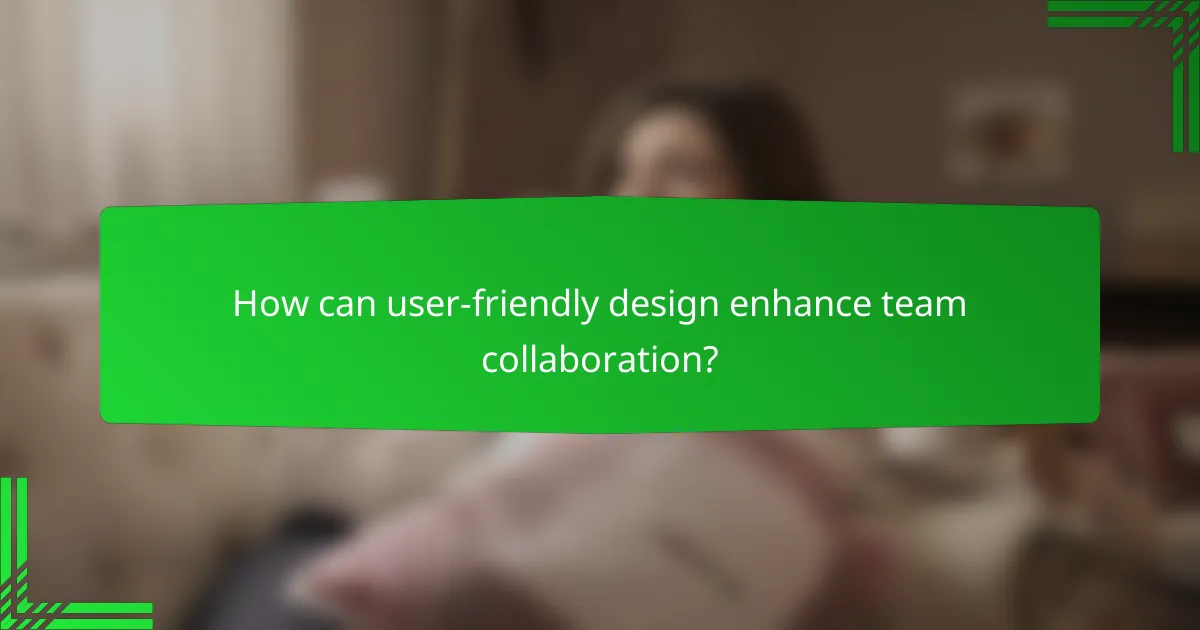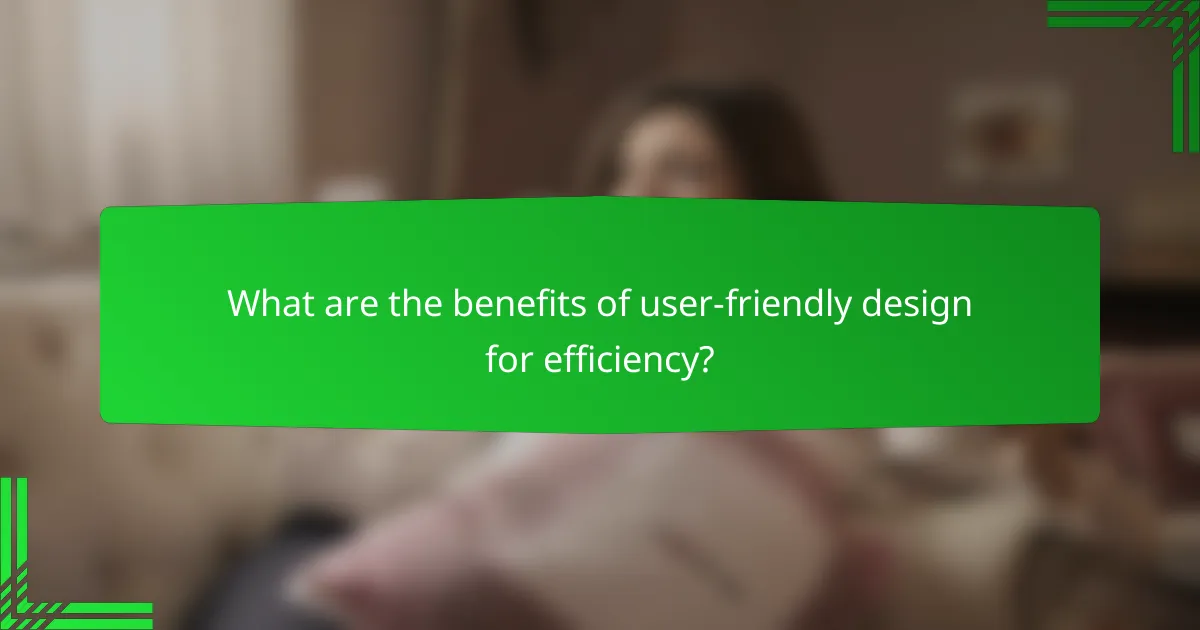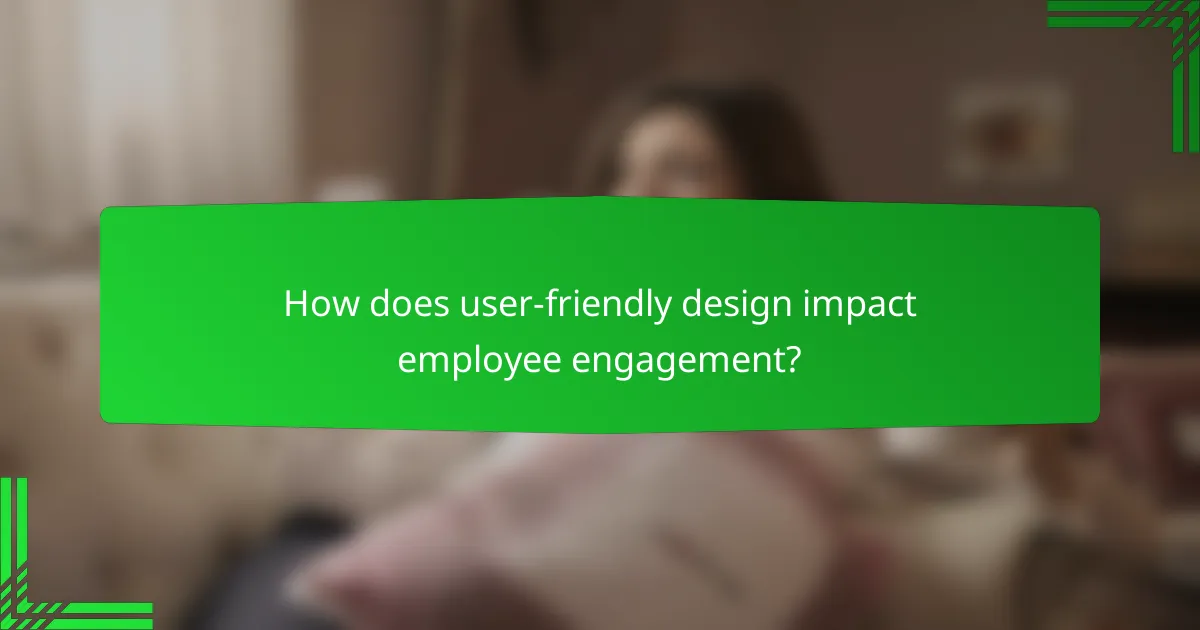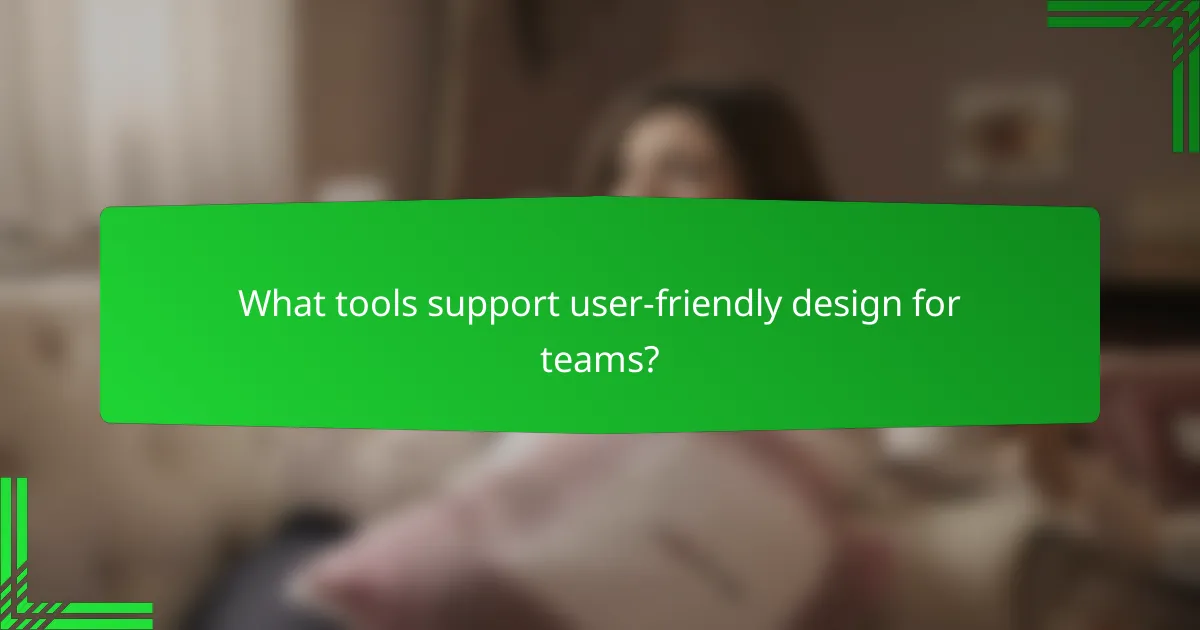User-friendly design plays a crucial role in fostering team collaboration, enhancing efficiency, and boosting employee engagement. By creating intuitive interfaces, teams can communicate more effectively and focus on their work without the frustration of complicated tools. This streamlined approach not only improves productivity but also cultivates a more motivated and connected workforce.

How can user-friendly design enhance team collaboration?
User-friendly design significantly enhances team collaboration by simplifying communication and making tools more accessible. When interfaces are intuitive, team members can focus on their tasks rather than struggling with technology, leading to increased productivity and engagement.
Improved communication tools
User-friendly communication tools facilitate clearer and more efficient exchanges among team members. Features such as instant messaging, video conferencing, and collaborative document editing allow for real-time interactions, reducing misunderstandings and delays.
To maximize the effectiveness of these tools, choose platforms that integrate seamlessly with existing workflows. For example, tools like Slack or Microsoft Teams can enhance communication by providing channels for specific projects or topics, ensuring that relevant information is easily accessible.
Streamlined project management
User-friendly design in project management software helps teams stay organized and on track. Intuitive dashboards and visual timelines allow team members to quickly understand project status and deadlines, which fosters accountability and transparency.
Consider using tools like Trello or Asana, which offer drag-and-drop functionalities and customizable views. This can help teams prioritize tasks effectively and allocate resources where they are most needed, ultimately improving project outcomes.
Visual collaboration platforms
Visual collaboration platforms enhance team brainstorming and idea generation by providing shared spaces for creativity. Tools like Miro or Figma allow team members to collaborate visually, making it easier to convey complex ideas through diagrams and prototypes.
When selecting a visual collaboration tool, ensure it supports real-time editing and feedback. This encourages participation from all team members, regardless of their location, and helps maintain engagement throughout the project lifecycle.

What are the benefits of user-friendly design for efficiency?
User-friendly design significantly enhances efficiency by streamlining workflows and reducing the time needed for users to adapt to new systems. When interfaces are intuitive, users can focus on their tasks rather than struggling with navigation or functionality.
Reduced training time
User-friendly design minimizes the learning curve for new users, leading to reduced training time. When systems are intuitive, employees can often learn to use them in a matter of hours instead of days, which is particularly beneficial for onboarding.
For example, a well-designed software interface might allow new hires to complete basic tasks within a single training session, while poorly designed systems could require multiple sessions spanning several days. This efficiency translates into cost savings for organizations.
Increased productivity
With user-friendly design, productivity tends to increase as employees spend less time figuring out how to use tools and more time completing their work. When users can navigate systems easily, they can accomplish tasks more quickly and effectively.
For instance, a streamlined project management tool that allows for quick task assignment and tracking can lead to faster project completion times. Studies show that organizations with user-centric designs often see productivity improvements in the range of 20-30%.
Minimized errors
User-friendly design helps to minimize errors by providing clear instructions and reducing complexity. When users can easily understand how to interact with a system, they are less likely to make mistakes that can lead to costly repercussions.
For example, an application that uses visual cues and confirmations can prevent users from accidentally deleting important data. Organizations can benefit from fewer errors, which not only saves time but also enhances overall quality and customer satisfaction.

How does user-friendly design impact employee engagement?
User-friendly design significantly enhances employee engagement by creating intuitive and efficient work environments. When employees find tools and systems easy to navigate, they are more likely to feel motivated and connected to their tasks.
Enhanced user satisfaction
User satisfaction is directly linked to how effectively employees can interact with their work tools. A well-designed interface reduces frustration and allows for smoother workflows, leading to a more enjoyable work experience. For instance, a user-friendly project management tool can streamline task assignments and tracking, making daily operations less cumbersome.
To enhance user satisfaction, organizations should prioritize usability testing and gather input from employees during the design process. This ensures that the final product aligns with user needs and preferences, ultimately fostering a positive work atmosphere.
Higher retention rates
Companies that invest in user-friendly design often see higher employee retention rates. When employees are satisfied with their work environment and tools, they are less likely to seek opportunities elsewhere. A seamless user experience can make daily tasks feel less tedious, encouraging employees to stay engaged and committed to their roles.
To improve retention, organizations should regularly assess and update their tools based on user feedback. Implementing changes that reflect employee preferences can create a sense of ownership and loyalty, reducing turnover.
Encouraged feedback loops
User-friendly design encourages open communication and feedback among team members. When systems are easy to use, employees are more likely to share their thoughts and suggestions, fostering a culture of continuous improvement. This feedback loop can lead to ongoing enhancements in tools and processes, benefiting the entire organization.
To facilitate effective feedback loops, companies should establish regular check-ins and surveys to gather employee insights. Creating a platform where employees feel comfortable sharing their experiences can lead to valuable improvements and a more engaged workforce.

What tools support user-friendly design for teams?
Several tools enhance user-friendly design by facilitating collaboration, communication, and project management among team members. These tools streamline workflows and improve overall efficiency, making it easier for teams to engage and create effective designs.
Trello for task management
Trello is a visual task management tool that uses boards, lists, and cards to help teams organize their projects. Each card can represent a task, allowing team members to assign responsibilities, set deadlines, and track progress in real-time.
To maximize Trello’s effectiveness, create boards for different projects and use labels to categorize tasks. This approach helps in quickly identifying priorities and managing workloads. Regularly review and update the boards to keep everyone aligned and accountable.
Slack for communication
Slack is a messaging platform designed for team communication, offering channels, direct messages, and integrations with other tools. It allows teams to communicate instantly, share files, and collaborate without the clutter of email.
To enhance user-friendly design discussions, create dedicated channels for specific projects or topics. Encourage team members to use threads for focused conversations, which keeps discussions organized and easy to follow. Regularly check in on channels to stay updated on team progress and feedback.
Miro for brainstorming
Miro is an online collaborative whiteboard platform that supports brainstorming sessions and visual collaboration. It allows teams to create mind maps, flowcharts, and diagrams, making it easier to visualize ideas and concepts collectively.
For effective brainstorming, set clear objectives for each session and invite team members to contribute ideas on the board. Use sticky notes and drawing tools to encourage creativity and engagement. After the session, summarize key takeaways and assign follow-up tasks to ensure progress on the ideas generated.

What criteria should be considered when selecting design tools?
When selecting design tools, prioritize user interface simplicity, integration capabilities, and scalability for teams. These criteria ensure that the tools enhance collaboration, streamline workflows, and adapt to the needs of growing teams.
User interface simplicity
A user-friendly interface is essential for effective design tools. It should allow team members to navigate easily without extensive training. Look for tools that offer intuitive layouts, clear icons, and straightforward workflows to minimize confusion and enhance productivity.
Consider tools that provide customizable dashboards or templates, which can help users quickly access frequently used features. This can significantly reduce the learning curve and increase overall engagement among team members.
Integration capabilities
Integration capabilities are crucial for ensuring that design tools work seamlessly with other software your team uses. Look for tools that can connect with project management platforms, communication apps, and file storage services to create a cohesive workflow.
Evaluate the APIs and plugins available for each tool. A strong integration ecosystem can save time and reduce errors by automating data transfers and updates across platforms, thereby enhancing team efficiency.
Scalability for teams
Scalability is important as your team grows or project demands change. Choose design tools that can accommodate an increasing number of users without sacrificing performance. This often means selecting tools that offer tiered pricing plans or flexible user management options.
Additionally, consider whether the tool can handle larger projects or more complex designs as your needs evolve. A scalable solution will allow your team to maintain productivity and collaboration without the need for frequent tool changes.

What are the emerging trends in user-friendly design?
Emerging trends in user-friendly design focus on enhancing user experiences through personalization, collaboration, and engagement. These trends leverage technology to create more intuitive and efficient interactions between users and digital platforms.
AI-driven design personalization
AI-driven design personalization tailors user experiences based on individual preferences and behaviors. By analyzing data, AI can suggest content, layouts, and features that resonate with specific users, enhancing satisfaction and engagement.
For example, e-commerce platforms often use AI to recommend products based on previous purchases or browsing history. This approach can increase conversion rates significantly, as users are more likely to engage with content that feels relevant to them.
When implementing AI personalization, ensure you respect user privacy and comply with regulations like GDPR. Always provide users with options to customize their experience or opt-out of data collection.
Remote collaboration enhancements
Remote collaboration enhancements are crucial for teams working in distributed environments. Tools that facilitate real-time communication, project management, and file sharing can significantly improve efficiency and engagement among team members.
Platforms like Slack and Microsoft Teams offer features such as video conferencing, task assignments, and integrated apps to streamline workflows. These tools help maintain a sense of connection and accountability, which is vital for remote teams.
To maximize the effectiveness of remote collaboration tools, establish clear guidelines for communication and project updates. Encourage regular check-ins and feedback sessions to keep everyone aligned and engaged.
